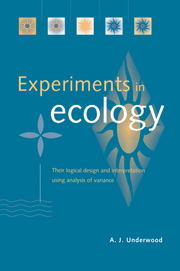Book contents
- Frontmatter
- Contents
- Acknowledgements
- 1 Introduction
- 2 A framework for investigating biological patterns and processes
- 3 Populations, frequency distributions and samples
- 4 Statistical tests of null hypotheses
- 5 Statistical tests on samples
- 6 Simple experiments comparing the means of two populations
- 7 Analysis of variance
- 8 More analysis of variance
- 9 Nested analyses of variance
- 10 Factorial experiments
- 11 Construction of any analysis from general principles
- 12 Some common and some particular experimental designs
- 13 Analyses involving relationships among variables
- 14 Conclusions: where to from here?
- References
- Author index
- Subject index
6 - Simple experiments comparing the means of two populations
Published online by Cambridge University Press: 05 June 2012
- Frontmatter
- Contents
- Acknowledgements
- 1 Introduction
- 2 A framework for investigating biological patterns and processes
- 3 Populations, frequency distributions and samples
- 4 Statistical tests of null hypotheses
- 5 Statistical tests on samples
- 6 Simple experiments comparing the means of two populations
- 7 Analysis of variance
- 8 More analysis of variance
- 9 Nested analyses of variance
- 10 Factorial experiments
- 11 Construction of any analysis from general principles
- 12 Some common and some particular experimental designs
- 13 Analyses involving relationships among variables
- 14 Conclusions: where to from here?
- References
- Author index
- Subject index
Summary
The logic and procedures used in the mensurative or goodness-of-fit tests described in the previous chapter can be used in much more useful and less contrived circumstances. The procedures of t-tests underpin a variety of different topics and tests (including, for example, analyses of regressions). Here, the usefulness of t-distributions and their underlying theory are discussed in comparisons of two populations where there are hypotheses about their means. These occur in a great variety of biological experiments and are one of the most widespread forms of experimentation used. The simplest cases concern what are known as paired data.
Paired comparisons
The classical case of paired comparisons is known as a ‘before–after’ contrast. This sort of experiment involves knowing something about a population before the application of an experimental treatment and then measuring it again after the treatment to test the hypothesis that the treatment makes some predicted difference. The same elements in the population are measured before and after the experiment.
Other situations involve naturally paired data. For example, the eldest male and eldest female siblings are naturally paired data – they must come from the same family. Another case involves measurements on the right-and left-hand side of an animal's body to test a null hypothesis in which one side of the animal has been experimentally treated in some way. A final situation where paired data can be used to test hypotheses about means is when there are two analytical procedures to be compared, for example a new and a previously standard method for determining the concentration of chlorophyll in leaves.
Information
- Type
- Chapter
- Information
- Experiments in EcologyTheir Logical Design and Interpretation Using Analysis of Variance, pp. 100 - 139Publisher: Cambridge University PressPrint publication year: 1996
